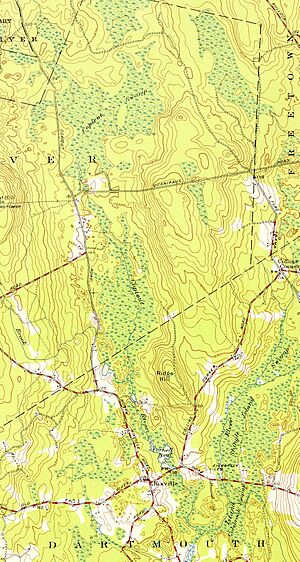Copicut River facts for kids
The Copicut River, also sometimes called the Copecut River, is a small stream about 2.2 miles (3.5 km) long in the U.S. state of Massachusetts. It's an important part of the local water system, connecting different ponds and rivers.
Contents
About the Copicut River
The Copicut River is a natural waterway that flows through a beautiful part of Massachusetts. It plays a role in the environment and local communities.
Where Does the River Flow?
The Copicut River starts in the Copicut Reservoir. This reservoir is located in the towns of Dartmouth and Fall River. From there, the river flows south. It ends its journey in Cornell Pond, which is near Hixville in Dartmouth.
The water's journey doesn't stop there! From Cornell Pond, another river called the Shingle Island River flows into Noquochoke Lake. Then, the East Branch Westport River carries the water from Noquochoke Lake all the way to the Rhode Island Sound. So, the Copicut River is like one small link in a much larger chain of waterways.
What is the Copicut Reservoir?
The Copicut Reservoir is where the Copicut River begins. This reservoir was once a natural wetland area known as the Copicut Swamp. Over time, it was developed into a reservoir, which is a large artificial lake used to store water.
Protecting the Copicut River
Like many natural places, the Copicut River has faced challenges, especially with pollution. Protecting our rivers and streams is very important for the health of the environment and the people who live nearby.
Why Was the River Polluted?
The Copicut River became polluted with harmful chemicals called Polychlorinated biphenyls (PCBs). These chemicals came from a company called Re-Solve, Inc. This company operated a facility nearby from 1956 to 1980. They handled chemicals, and unfortunately, some of these dangerous substances ended up in the river and surrounding areas.
What is a Superfund Site?
Because the pollution was so serious, the Environmental Protection Agency (EPA) stepped in. The EPA is a government agency that works to protect human health and the environment. In 1983, they listed the polluted area around the Copicut River as a Superfund site.
A Superfund site is a place that has been badly contaminated by hazardous waste. The EPA then works to clean up these sites to make them safe again. It's a big job to remove dangerous chemicals from the environment.
How Was the River Cleaned Up?
To clean up the Copicut River area, the EPA took action. In 1985, they removed a large amount of contaminated soil and sludge. This was about 15,000 cubic yards (11,000 cubic meters) of polluted material. Removing these materials helped to reduce the amount of harmful chemicals in the environment.
Is the River Safe Now?
Even after the cleanup, there are still some concerns. Since 1988, the Massachusetts Department of Public Health has advised people not to eat fish caught from Cornell Pond or the Copicut River. This advice is given to make sure people stay safe and avoid any remaining chemicals that might be in the fish. It shows that even after a cleanup, it can take a long time for an environment to fully recover.


